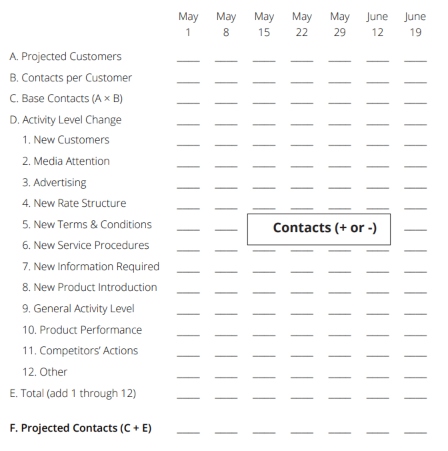By
Brad Cleveland
|
Date Published: May 03, 2023 - Last Updated October 30, 2023
|
Comments
I recall a consulting project with a company struggling to provide consistent service to its customers. At times, customers had to endure painfully long waits. Other times, though, employees were sitting idle for long periods. It became apparent that inaccurate forecasts were a big part of the problem. An even bigger problem was a mental hurdle: They were convinced that accurate forecasting was impossible.
We were having lunch together, and I asked their management team how long I should allow to reach the airport that afternoon. They knew almost to the minute what it would take.
“If you leave by 4, the expressway will get you there in 30 minutes,” said one.
“If you wait until 4:30, it will take 45 minutes,” added another.
“Wait,” I teased with a smile. “Those are forecasts. With all the variables that impact traffic, can I be sure they are accurate?”
They laughed and promised to give their forecasts more attention. And in the coming weeks, they did. They looked for underlying patterns. They removed anomalies in the data. They put together a small cross-functional team to add judgment.
The result? They got better at forecasting. Much better. In fact, they’re usually accurate within 5% of actuals (down to half-hour increments). Their newfound confidence in forecasting has paid off in better queue management, less stress on employees, and more consistent service to their customers.
An essential part of the answer for that organization was, first and foremost, to believe that it’s possible to improve forecasts - even given new competition, an uncertain economic outlook, AI and other tech developments, and other variables driving relentless change.
Next, they realized that what their workforce management (WFM) system was spitting out was just a start. They needed to be more involved in the process and, particularly, in judgmental forecasting.
Quantitative forecasting uses hard data in the forecasting process—historical patterns and so forth. Quantitative data forms the baseline for most contact center forecasts, and you need it. But you also need judgment. Judgmental forecasting goes beyond purely statistical techniques and encompasses what people think will happen. It is in the realm of intuition, interdepartmental committees, market research, and executive opinion.
Some judgment is inherent in virtually all forms of forecasting, and a degree of good judgment can significantly improve accuracy. The trick is to combine quantitative and judgmental approaches effectively and to be aware of the limitations of each.
This worksheet illustrates a basic way of applying common sense and a logical approach to judgmental forecasting. In a customer service environment, the number of contacts is often primarily a function of the total number of customers in the organization’s universe. It is possible to project contacts based on historical data, utilizing the relationships between contact volume and total customers (contacts per customer). The forecast will be accurate to the degree that the future echoes the past.
 Part D of the form is where judgment plays a significant role. In this section, you customize the forecast by adding or reducing contacts based on the information you develop from your input and others’ input. For some of these factors, you may have hard data that you can use. For others, you’ll make more of an “educated guess.”
Part D of the form is where judgment plays a significant role. In this section, you customize the forecast by adding or reducing contacts based on the information you develop from your input and others’ input. For some of these factors, you may have hard data that you can use. For others, you’ll make more of an “educated guess.”
The factors in Part D are only examples; you will want to create a list specific to your environment. For instance, the weather would be a key influence on the workload in a support center for broken-down or stranded vehicles. Evolving AI capabilities might be a variable you consider as you incorporate new technologies into services.
You will need a routine mechanism or forum for blending judgment into the forecast. A common approach in contact centers is a weekly forecasting meeting. These meetings typically include members of the WFM team and a representation of supervisors and managers from the contact center and other departments.
The meeting will typically last only 30 or 45 minutes. It often works like this:
- The person in charge of the meeting prepares an agenda of items to be discussed.
- The forecasting lead or WFM team prepares the quantitative forecast before the meeting.
- During the meeting, the attendees discuss issues that may influence the forecast, such as those in Part D of the worksheet. Each participant brings a unique perspective to the process.
- As each issue is discussed, the forecast is adjusted up or down based on what the group believes will happen.
Some organizations build this basic approach to include how average handling times change, how specific customer segments are impacted, and so forth. All fine. The point is to get started. Maintain an approach that is active and dynamic in considering developments impacting the contact center’s workload.
The collaborative approach is most effective when key team members accountable for staffing take an active role in forecasting; in large contact centers, they can be rotated through this process. The forecast not only improves from their perspective, but these key team members gain an understanding of the factors that contribute to staffing. As a result, they lead their teams more effectively.
Are your forecasts off the mark? Give them another look. I’m convinced you can create accurate forecasts that lead to improved queue management and a better experience for your customers.